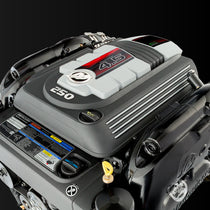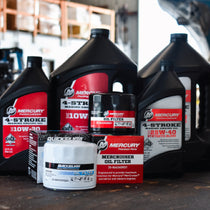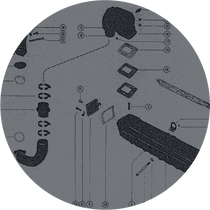It’s that time of year again, and unfortunately, it’s time to think about storing your boat for the season. While it’s always a bit more fun to pull out your boat than to put it away, properly winterizing your MerCruiser sterndrive engine avoids engine damage and will facilitate a smooth start to the beginning of next season.
While there are several things you can do before storing your boat to get a jump on next season—like changing your oil and changing your fuel-water separating filter—there are six highly recommended steps. Here’s a brief summary of how to winterize a MerCruiser sterndrive:
- Flush your MerCruiser engine
- Stabilize your fuel system
- Drain water and fill engine with antifreeze
- Fog your MerCruiser sterndrive engine
- Change lower unit oil
- Disconnect your battery

Flush Your Engine
It’s important to thoroughly flush your engine to remove any salt buildup if you are a saltwater boater, or general mud and grime if you are a freshwater boater. Failure to remove this debris can cause or contribute to corrosion in the engine. If you’re a saltwater boater, salt crystals in the lower unit can cause a great deal of damage.
Flush with the Engine Not Running (using a hose port)
You’ll need:
- Garden hose
- Water supply
If your engine has a hose adapter, simply screw the hose into the port, turn on the water and let the water run for about 5 minutes.
Finally, tilt the engine all the way up, then trim it all of the way down to make sure every drop of water drains from the engine.
**Caution** Do not run the engine when flushing while using a hose port. This method is solely designed for flushing while your engine is entirely off.
Flushing Your MerCruiser Sterndrive with the Engine Running
You’ll need:
- Motor flusher
- Garden hose
- Water supply
To flush your outboard with the engine running, you will use a motor flusher. We recommend a Quicksilver pin motor flusher, rather than earmuffs. Earmuffs have a tendency to fall off when flushing a sterndrive, but the pin flusher configuration stays very secure.
Screw your garden hose onto the motor flusher, then slide the motor flusher over the engine’s water intakes. You must be sure that the earmuffs are completely covering the water intakes. Using this flushing method, you will turn on the engine. But first, make sure that you have a good water supply.
Start the engine and make sure that water is flowing from the back of the engine. Assure that your engine is not overheating by holding your hand under the flow of water. It should not be uncomfortable to hold your hand in the stream of water. If the water is excessively hot, water is not flowing correctly, and you are overheating your engine—turn off the engine, reposition the flusher, and start again.

Stabilize Your MerCruiser’s Fuel System
You’ll need:
- Fuel stabilizer suitable for long-term storage
Because it is so common, many of us use ethanol-enriched gasoline much of the time. We recommend using a fuel stabilizer all of the time when running ethanol-enriched gasoline. Read our Ethanol Gasoline In Outboard Engines article to learn why. Additionally, it is vital to use a fuel stabilizer like Mercury Quickstor when your boat will be sitting unused for any more than two or three months.
Add the amount of fuel stabilizer directed on the product’s packing to your fuel—for instance, 1 ounce of Mercury Quickstor for every 5 gallons of gasoline.
Run the engine with stabilized fuel for 10-15 minutes to thoroughly circulate the stabilized fuel throughout your fuel system.
Drain the Engine and Add Antifreeze
You’ll need:
- 3-4 gallons of antifreeze
- Winterization kit or hose
- Motor flusher
- Garden hose
- Water supply
Adding antifreeze and fogging the engine have to be done consecutively with the engine running. Start with draining the engine and adding antifreeze.
Remove all of the drain plugs to get all of the water out, so reference your service manual for the drain plug locations. Some newer MerCruiser models have a quick drain system, so again, check your owner’s manual.
Poke around all of the drain holes with a small screwdriver to make sure that there is no debris blocking water from draining.
**Caution** Inadvertently leaving water in the engine is a very expensive mistake. Any water left inside poses a freezing risk which can crack the block or manifold.
Once the engine is drained, put the plugs back in.
Secure your motor flusher to the intake on the drive and turn on the water.
Attach a hose to the antifreeze source, then run the engine while making sure the antifreeze is being consumed.
When the antifreeze goes through the engine, it actually comes out the exhaust, so when you start seeing antifreeze being exhibited out the exhaust, you know that the block and manifolds are full.
Fogging Your Engine
You’ll need:
- Fogging oil
So, what is fogging oil or fogging fluid anyway? Fogging oil is a wax-based oil that coats the engine and prevents corrosion. As you work through this process, you will soon understand why this process is called fogging the engine, as there will be plenty of white smoke.
You will perform this step directly after adding antifreeze, so keep your engine running.
Remove the flame arrester covering the carburetor.
Rev the engine to a bit above idle, and with the engine running, spray the fogging oil down into the carburetor.
Continuously spray fogging oil into your engine’s carburetor until the engine stalls. Don’t spray too much oil at once and kill the engine immediately, but after a continuous spray, the engine will eventually stall. This is precisely what you want, and the ultimate stalling indicates that the engine is thoroughly covered with fogging oil.
**Note** This fogging process is for carbureted engines only. EFI engines have a slightly different fogging procedure.

Change Lower Unit Oil
You’ll need:
- Sufficient quantity of lower unit oil / gear lube oil
- Oil pump
- Drain pan
- Large flat head screwdriver
- A few rags
We strongly recommend changing your lower unit oil before storage to make sure there is no water in the lower unit’s oil. Any water in the oil could freeze, expand, and crack your lower unit. Also, changing lower unit oil means one less thing to do at the beginning of next season.
First, you’ll need to know how much lower unit oil / gear lube you need to fill your lower unit – check your owner’s manual.
Locate the lower and upper lower unit oil drain holes. With your drain pan in position, first, remove the lower drain screw. The oil will start to drip out into the drain pan.
Next, remove the upper drain screw—oil will drain out quickly. Allow the oil to drain completely.
It is essential that you pay close attention to your lower unit’s oil. If the oil is a milky color, there is water in the lower unit, and you will have significant problems down the road. If this is the case, go directly to your marine mechanic to diagnose the problem and hopefully fix the issue before it causes more damage.
With the oil completely drained, screw in your pump fitting and attach the pump. Remove the cap of your bottle of lower unit oil and screw the pump onto the bottle.
Pump until oil begins flowing out of the upper drain hole.
Insert your upper screw plug, hand tighten, then tighten securely with your flathead screwdriver.
With the lower screw in your hand, remove the oil pump fitting. Quickly insert and tighten the lower screw.
Wipe everything down and properly dispose of your old oil lower unit oil.
**Caution**
There must be no water in your lower unit oil. If there is water in the lower unit oil and your boat is stored in the cold, the water in the oil will freeze and crack your lower unit, which is definitely a bad thing.
Disconnect Your Battery
You’ll need:
- Battery terminal cleaner and protector
Disconnect your battery and spray a marine battery terminal protector on your battery terminals.
PartsVu offers all of the MerCruiser parts and products you need to maintain your engine – we’re here to help with a full MerCruiser catalog, great prices, and fast shipping.


















